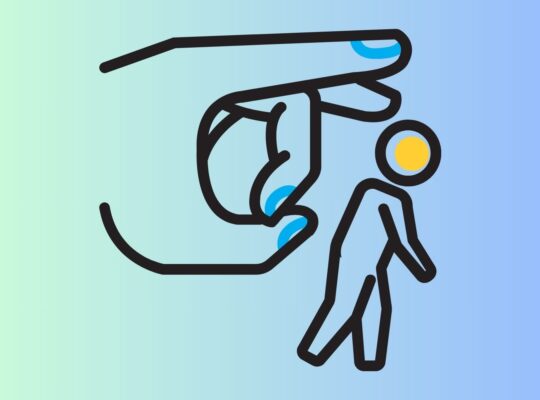In this article: Learn how to overcome fear using the power of positive actions and enjoy inner peace and calm in a turbulent changing world.
The Emotion Of Fear
“He who is not everyday conquering some fear has not learned the secret of life.” – Ralph Waldo Emerson
Fear is known as one of the seven universal emotions experienced by humans. Fear is an emotion that presents itself in response to threat of harm, whether physical, emotional, or psychological, and whether that threat is real or imagined.
Typically, fear is viewed as a negative emotion, though in many instances it serves the vital purpose of activating us so we can cope with potential danger (Paul EkmanGroup, 2020). In times of crisis and uncertainty, fear can absolutely dominate one’s thoughts and emotions.
In these situations, a lack of clarity and certainty regarding the future can lead to fear, anxiety, panic, and great emotional stress that can escalate if not managed.
Physiological Fear Response
While fear is certainly an emotion, it also produces a physiological response often referred to as the fight-or-flight response. As fear is experienced, breathing increases, heart rate increases, peripheral blood vessels constrict, central blood vessels around essential organs dilate, and muscles are filled with blood.
All of this happens as a means of preparing the body to respond to whatever is triggering the fear. From a metabolic standpoint, levels of glucose in the blood rise to offer a store of energy should the need to react arise. Similarly, levels of calcium and white blood cells in the bloodstream see an increase (Newman, 2020).
Fear can also be explained via Hans Selye’s stages of how the body responds to stressors, known as general adaptation syndrome (Rosenberg, 2017):
- Alarm: The first reaction to stress recognizes there’s a danger and prepares to deal with the threat. The hypothalamic-pituitary-adrenal (HPA) axis and autonomic nervous system are activated. Primary stress hormones cortisol, adrenaline, and non-adrenaline are released.
- Resistance: Homeostasis begins restoring balance and a period of recovery for repair and renewal takes place. Stress hormones may return to normal, but there may be reduced defenses and adaptive energy left.
- Exhaustion: At this phase, the stress has continued for some time. The body’s ability to resist is lost because its adaption energy supply is gone. This is often referred to as overload, burnout, adrenal fatigue, maladaptation, or dysfunction.
What Drives Fear
As people have made strides to better understand fear, another area of study has been what factors drive our specific fears. It’s true that not everyone is afraid of the same things, but it is also true that many people can be afraid of the same things.
Of the many research studies conducted in this particular area, some of the major drivers of fear that have been identified include social influence, mental health, memories, and our biology (Menting, 2020).
Of course, during times of global crisis and turmoil, such as pandemic, war, political and social unrest or even living in a high crime area fear can become more common among the population as a whole.
With regards to the impact of social influence on influencing fear, a 2005 poll of United States teenagers found that events/experience on their list of top ten fears included items such as terrorist attacks, war, and nuclear war although their personal life experience was incredibly limited in these areas.
Hadjikhani and her team who conducted this particular research uncovered the phenomenon of contagion fear in their results. They ultimately found that humans can indirectly experience fear through something as simple as another person’s look or muscle tensing, or on a larger scale via panic and pandemonium experienced when a wide-scale trauma happens (i.e. terrorist attack, mass shooting, etc.).
Hadjikhani’s research went on to show that the brain could recognize fear via expressions, body movements, and posture which then work as one method of developing a learned/conditioned fear response that is impressed so firmly within the memory it cannot be removed, even without direct exposure to the trigger (Menting, 2020).
Another driver of fear noted was that of mental health, or rather mental illness. Nearly 19 million people in the U.S. have mental illnesses that include persistent outsized fear responses to seemingly ordinary stimuli. A condition most often associated with this is post-traumatic stress disorder.
HMS associate professor of psychiatry and director of McLean Hospital’s Cellular Neurobiology Laboratory, Vadim Bolshakov, studied the link between fear and brain health via studies on rats. One of the major findings in his research identified two proteins essential to the innate and learned fear responses.
When the researchers blocked production of one of the proteins, stathmin, fear–conditioned mice were less able to recall the learned fear—and lost the ability to recognize dangers that normally would have kicked their innate fear response into high gear.
Blocking the gene that produces a protein known as transient receptor potential channel 5, normally found in high concentrations in the amygdala, decreased the rodents’ neurons’ sensitivity to cholecystokinin, a neuropeptide released when the innate fear response is triggered or a learned fear is recalled. This hinted at the notion that if a mental illness were present that interfered with those proteins it could then influence fear responses (Menting, 2020).
Memory is another factor outlined as driving fear. Researcher Roger Pitman notes there is no concrete way to abolish a learned fear which is established via the process of memory. In a controlled study of patients entering Mass General’s emergency department after traumatic experiences—assaults or car accidents, for example—Pitman provided some participants with a placebo and others with propranolol, a drug that blocks the effects of the hormone adrenaline.
At follow–up interviews participants listened to audiotapes of their own accounts of their trauma the day it occurred. Propranolol recipients had weaker physical responses to the tapes than placebo users, who showed physical signs of the stirring of their fearful memory despite time’s passage.
Ultimately, the results demonstrated that to combat fear forming in response to a memory, the best approach was to prevent the memory from forming in the brain in the first place (Menting, 2020). Though additional research has shown that time can weaken the intensity of a response to a given memory to a safety memory instead of a fear memory.
A final factor discussed is that of biology, specifically hormones and biological cycles. Some studies suggest that estrogen enhances fear learning, and stats the report anxiety disorders are twice as high in women seem to support this idea.
Additionally, women with higher estrogen levels showed stronger activation of the ventromedial prefrontal cortex, a brain region key to fear control. And men’s ability to control fear was akin to that of women who had high-estrogen levels.
When similar research was conducted in rats, scientists manipulated estrogen levels and found that blocking estrogen impaired the animals’ ability to control fear while reintroducing estrogen caused the rats to behave as if they felt safe. Thus, there may be evidence to support the notion that hormones do in fact impact how we respond to certain stimuli (Menting, 2020).
He who has overcome his fears will truly be free.
Aristotle
The Effects Of Fear On The Body
Persistent fear can be problematic, often turning into chronic stress and anxiety. Over time this can lead to mental, emotional, and even physical health issues.
- Associate Professor at Pacific Lutheran University School of Nursing and director of Psychiatric Services, Northwest Center for Integrated Health, Mary D. Moller, outlined some of the major impacts of fear on overall physical, emotional, and mental health systems as autonomic nervous system alterations, endocrine system dysfunction, immune system breakdown, sleep cycle disruptions, eating disorders, and variations in hypothalamus-pituitary-adrenal axis (Rosenberg, 2017). Physically, those effects can include headaches, muscle pain, and chronic pain conditions such as fibromyalgia (Rosenberg, 2017).
- Additionally, the constant stress response induced by fear which results in the release of the toxic chemical cortisol within the body often results in a weakened immune system, and health problems such as cardiovascular damage, gastrointestinal problems, and even decreased fertility.
- There are also links between prolonged feelings of fear and increased aging and premature death (Towey, n.d.).
- Emotionally, the impacts of fear can include anxiety, mood swings, obsessive-compulsive thoughts, learned helplessness, dissociation from self, and lack of emotion (Rosenberg, 2017).
- Fatigue, anxiety, and depression are also commonly associated with prolonged exposure to threatening experiences that induce fear.
- Evidence has also shown that living with constant fear interrupts processes in the brain that aid in emotional regulation and decision-making, making us more likely to make poor decisions and overreact emotionally.
- Fear also impairs the formation of long-term memories and damages the hippocampus within the brain (Towey, n.d.).
- Other possible impacts of fear include environmental health. For instance, an inability to engage in society with peers due to fear and anxiety. Or paranoia that impacts daily decision making due to fear.
- Also, fear leading to poor judgment ultimately leading to poor decision-making which leads people into very compromising positions that can go on to negatively impact their lives for the long-term (Rosenberg, 2017).
For all of these reasons, getting a handle on fear is of vital importance in order to live a healthy and whole life, mentally, emotionally, and physically.
20 Ways To Counter Fear with Positive Action
Inaction breeds doubt and fear. Action breeds confidence and courage. If you want to conquer fear, do not sit home and think about it. Go out and get busy.
Dale Carnegie
Fear is likely unavoidable, but we don’t have to simply allow fear to wreak havoc in our lives. We can take action when faced with fear versus allowing fear to get the best of us.
The following outlines a list of steps and actions that can be taken and implemented to counter fear in everyday life. These tips can be implemented immediately when faced with fear as a means of coping and combatting fear.
1| Identify the Fear
Nothing in life is to be feared. It is only to be understood.
– Marie Curie
In order to deal with our fears during times of crisis, we must first understand what those fears are. Thus, when we feel fear it is important to pause and think about what exactly is causing the fear.
Is it a fear of the unknown?
Is it a fear of a worst-case scenario?
Is it a fear of experiencing some type of pain?
In some instances, there may be a genuine outside or inside cause for the fear. However, there may also be instances where taking the time to identify the fear also reveals that the fear isn’t rooted in reality or truth.
Thus, demystifying it and making it less scary and more manageable. When you realize there is nothing to fear or understand what the specific fear is, you are better able to handle it (Steimle, 2016).
2| Think Positively
Positive thinking is a way to regain control during times of distress and uncertainty when fear tries to dominate. Fear often works by causing people to consider the worst-case scenario.
Positive thinking is about choosing not to focus on potential negative outcomes. Rather it is about finding the current good within a situation and highlighting that.
It is about a conscious pivot away from the negative source/stressor and towards a more positive focus. By shifting your thoughts, you can shift your focus, and essentially dissipate your fear (Steimle, 2016).
3| Relaxation Techniques
Relaxation techniques are forms of stress management that work to decrease the effects of stress on the mind and body. This can be especially useful during crisis situations where anxiety and panic can override and overwhelm.
When practiced these techniques can improve mood, reduce stress hormones, slow breathing, decrease heart rate, and reduce frustration, all of which can be associated with fear.
Relaxation techniques can include things such as yoga, massage, aromatherapy, music, and art among others (Mayo Clinic, 2020).
4| Breathe
Breathing is a good strategy for regaining a sense of calm in the midst of fear. Breathing offers the opportunity to take the time to pause, refocus, and really process what is happening and what you are feeling.
Breathing can ground you and help you get to a place where you can identify the root of your fear and create a solution to address the trigger.
Additionally, the breathing will have an immediate effect by reducing the heart rate and allowing the brain to process information more effectively so that reasonable/rational decisions can be made (Amatenstein, 2020).
5| Patience
It may seem counterintuitive to not act when feeling fearful, but this may actually be one of the best steps to take. Fear, as previously mentioned, can cause irrational thought and poor decision making.
Taking some time to just sit with your feelings can help you realize that the fear isn’t valid, help you reason through the fear, or help you develop a solution to adequately address it (Amatenstein, 2020).
6| Self-Care
Self-care is a way to address the mental and emotional impacts fear can have on the body. Self-care is about prioritizing the protection of well-being and happiness, particularly during periods of stress such as fear.
Such methods of self-care can include mindfulness meditation, physical activity, or even journaling. Each of these activities and other self-care activities focus on reducing stress and anxiety by providing an outlet to release feelings so they don’t build up and escalate (Robbins, 2020).
7| Ask for Help
One of the best ways to overcome fear is to seek help. When we are experiencing a crisis, it can be tempting to isolate because of shame or concern for ourselves or others.
But whether it’s help coping with the fear or help actually conquering the fear, reaching out to others to get support ensures that fear doesn’t get the best of you and that it does not cause you to cave under the stress or make poor decisions (Steimle, 2016).
Others can provide the emotional support needed to help us process our feelings and develop coping methods so we can remain strong in the midst of the crisis.
8| Get Informed
Often, fear is fueled by the unknown. What we don’t know seems to cause us to panic and think about worst case scenario situations, especially during a crisis. Thus, one of the best ways to manage fear is to find information.
Once we understand a situation or scenario, we are in a much better situation to address it. Things often become much less intimidating and fearful when we have a clear understanding of them (Steimle, 2016).
Thus, finding reputable sources of information can act to debunk our fears by empowering us with knowledge.
9| Visualize
Visualization is a process of mental mapping or imaging that can be very useful when it comes to dealing with fear. When faced with a situation or stimulus that causes fear, visualizing the steps you can take to overcome the situation or tackle the stimulus creates a type of muscle memory in the brain.
Then, by the time you actually get ready to do the action your brain is more likely to follow the pre-ordained steps, which eliminates fear of the unknown and ensures greater chances of success (Steimle, 2016).
10| Affirmations
An affirmation is a phrase or sentence designed to influence the conscious and subconscious mind. The ultimate effect being changes to our thought processes, habits, environments, behaviors, and actions as a result.
When faced with fear the goal should be to speak affirmations that encourage, uplift, and pivot from the ‘scary’ trigger, thereby reinforcing positive thoughts and positivity directly combatting the fear.
11| Role Models
This tip may seem like an odd choice, but a role model can be of great help when tackling fear. Role models are people who set an example for us to follow and imitate.
When we are in situations where fear is preventing us from being able to move forward, finding individuals who possess the characteristic of fearlessness or who have conquered a particular fear you are facing is a strong counter to give you the encouragement and motivation needed to move forward (Steimle, 2020).
12| Gratitude
“You gain strength, courage and confidence by every experience in which you really stop to look fear in the face. You are able to say to yourself, ‘I have lived through this horror. I can take the next thing that comes along.’ You must do the thing you think you cannot do.”
Eleanor Roosevelt
Being grateful can serve as a powerful means of refocusing attention and energy when in the midst of fearful situations. Gratitude can ground you in positive thoughts when fear tries to overwhelm and override.
Gratitude can be written or simply reflected on in times of stress to generate the mental and emotional relief needed to combat fear (Amatenstein, 2020).
13| Humor
Finding something to laugh about is another great strategy for dealing with fear. In crisis situations we are often only surrounded by the negativity and severity of the situation at hand. But it is hard to remain afraid when you’re laughing.
Whether it’s a joke, a television show, or a funny video, humor will shift focus from the stressor and diffuse the fear response, thereby giving you the peace and distance from the situation to help you calm down and remain grounded (Amatenstein, 2020).
14| Exercise
“The brave man is not he who does not feel afraid, but he who conquers that fear.” – Nelson Mandela
A little physical activity can produce a physical response in the body that is great for fighting against fear. When we engage in any kind of physical activity, there is a release of endorphins that cause an analgesic effect within the body. This means we feel calmer, less stressed, and have more mental clarity. Turning to exercise during seasons of fear can help immediately calm the emotional reaction so that no rash decisions or judgments are made (Amastein, 2020).
15| Meditation
Meditation is the practice of focusing on a specific thing (breathing, body sensation, or object) as a means of developing self-awareness, inducing calm, and increasing attention.
Meditation can be used to combat fear by intentionally choosing to focus on something other than the trigger causing the fear and regularly engaging in the practice as a means of redirecting and gaining control of your thoughts.
Through meditation you can manage and calm your fears and thus manage distressing situations (NHS, 2020).
16| Spirituality
If you are a person who is spiritual or religious, tapping into that source can be a solid way to fight against fear. Spirituality can act as a grounding force reminding you that there is a larger entity in control and that there is something larger than self.
This can be of great significance when in a crisis situation. When you remember that there is a greater power at work, you can find peace and manage stress/fear in a healthy way versus letting the crisis get the best of you (Mental Health Foundation, 2020).
17| Talk it Out
One of the best ways to cope with fear is to talk about it. When we talk about our fears we can often get to the root of them, either realizing they aren’t things we need to be fearful about at all, or at the least being able to vent about our fears so they don’t stay trapped in our heads and build up.
It’s also through talking that we can often come up with solutions to address the triggers of our fears (NHS, 2020).
18| Envision the Worst-Case Scenario
“Fear keeps us focused on the past or worried about the future. If we can acknowledge our fear, we can realize that right now we are okay. Right now, today, we are still alive, and our bodies are working marvelously. Our eyes can still see the beautiful sky. Our ears can still hear the voices of our loved ones.”
Thich Nhat Hanh
One of the best ways to tackle fear is to take the “scary’ part out of it by considering the absolute worst-case scenario. When you think about the worst thing that could happen, fear of the unknown is no longer a thing. So, the ‘what ifs’ hold no power over you if you’ve already considered them (NHS, 2020).
Though initially confronting the worst possible scenario of a crisis situation can be challenging, confronting it head-on takes the mystery of it. It also can allow a measure of planning to take place in case the worst-case comes to pass.
19| Sleep
A good night’s sleep or a quick nap can work wonders in terms of countering fear. When we sleep, we go into a relaxed state that allows for a release of stress and tension.
Sleep can help one process fear and reason through the negative feelings so that by the time one awakes the fear isn’t so threatening and the stress level isn’t so high (Mental Health Foundation, 2020).
20| Diet
When all else fails, there are foods that can be taken to combat the negative effects of fear. Such foods combat the negative feelings of stress and anxiety that often accompany fear and fear-based responses.
Such foods include dark chocolate, turmeric, and chamomile which have relaxing properties and can combat fear by creating a calming effect in the body.
Final Thoughts
We can get the upper hand over fear when faced with distressing situations. The strategies mentioned above and others like it can ensure that we are able to process fear and navigate through it in a healthy way so that it doesn’t hold us hostage, but rather propels us forward.
“I’m not afraid of storms, for I’m learning how to sail my ship.”
Louisa May Alcott
References
Mayo Clinic. (2020, April 18). Relaxation techniques: Try these steps to reduce stress.
Mental Health Foundation. (2020, April 30). How to overcome fear and anxiety.
Menting, A. (2020). The CHILL of fear. Harvard Medical School.
Newman, T. (2020). Fear: What happens in the brain and body? Medical and health information.
Paul Ekman Group. (2020, January 30). What is Fear?
Rosenberg. (2017). The effects of chronic fear on a person’s health. AJMC.
Steimle, J. (2016, January 12). 14 ways to conquer fear. Forbes.
Towey, S. (n.d.). Impact of fear and anxiety. Taking Charge of Your Health & Wellbeing.







